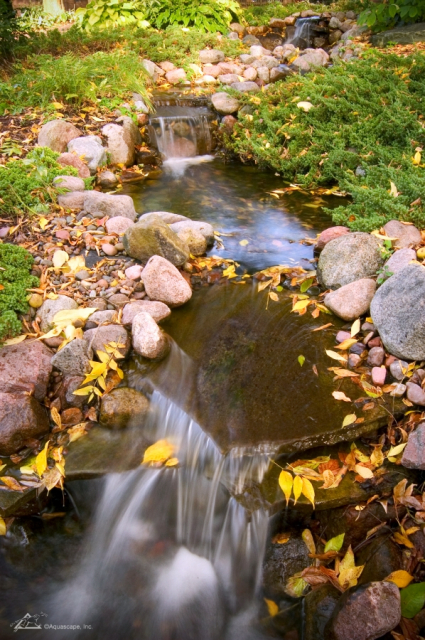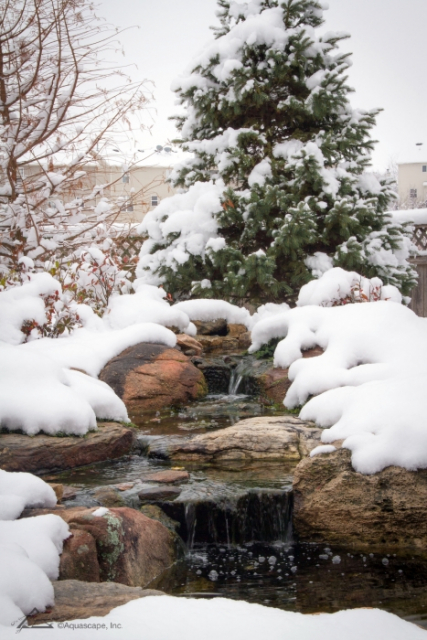Putting your pond to bed for winter doesn’t need to be an arduous process. Sure, it’s sad to say goodbye to your finned friends for a few months, but following a few simple tips will ensure that your resident aquatic life and fish joyfully greet you again in the spring.
1. Remove leaves and debris
By now you’ll probably have a build up of leaves and debris that need to be removed. A long-handled pond net makes an easy job of scooping the debris from the bottom of the pond. A short term impact of leaving leaf debris in your skimmer or pond for an extended period of time is the browning of your pond water. Long term, the excessive nutrient rich silt now at the bottom of your pond will create a delicious meal for an influx of unwanted algae in the spring, yum!

2. Clean the skimmer basket
Check the skimmer basket every few days and remove any debris. Once all the leaves have fallen, you won’t need to check it as frequently. If your skimmer starts to make unusual noises or your waterfalls thin to a trickle, a full skimmer will almost certainly be the cause.
3. Trim dead or dying foliage
During these colder months the health of your plants will deteriorate with an increasing number of dead and brown leaves. These should be cut back on both your aquatic and terrestrial plants in preparation for the winter season. If dead leaves from in and around your pond find their way into the water it is essential the majority are removed to keep organic matter contents at a manageable level.
4. Add cold water bacteria
Add Cold Water Beneficial Bacteria to help keep pond water clean and clear in low temperatures. Regular use of this bacteria will help maintain water quality and clarity, as well as dramatically reduce spring maintenance by digesting debris that may accumulate over the winter months.
5. Leaving your pond running
We cannot stress enough how important it is to keep your pump running throughout the winter season on your ecosystem pond! Proper filtration and aeration are 2 of the essential components of a complete ecosystem and are provided by the pumps for your pond being on at all times. Without the constant water flow there will be no aeration from the water flowing out of the Biofalls and the beneficial bacteria that accumulate on the filter pads will be made redundant.
If the mechanics weren’t enough to justify leaving your pumps on then the added aesthetic beauty should be! Waterfalls and streams during the winter look magnificent, with ice formations altering the water’s path and creating a new characteristic to your feature that can only be enjoyed at this time of year.
Keep in mind, there will still be a bit of maintenance required this time of year, such as topping up the pond due to wind blow off and ice formation. Also, you’ll need to make sure ice formations don’t create dams that can cause unnecessary water loss over the edge of the stream. During extreme cold snaps, the surface of your pond might completely freeze over, even with the waterfall running. Keep a hole in the ice with an aerator or in-pond pump, alternatively something floaty like a tennis ball or polystyrene will also help.

6. Ensure healthy fish before winter
A well-balanced diet creates healthy, happy fish. You want to make sure your fish are in good condition before they go into hibernation usually between November and February. When the water temperature falls below 15 degrees, the metabolism and digestion of your fish begins to slow down. Feed your fish with cold weather fish food but stop feeding them when the water temperature drops below 10 degrees as the fish will be in a state of dormancy, (do you blame them!)
When looking for a place to hibernate they prefer cool, damp, and dark shelter where they can rest safe from any predators. Some frogs and newts choose to hibernate in the shallow substrate layer at the bottom of a still water/ecosystem pond, burying themselves in the gravels and absorbing oxygen through their skin. Your still water/ecosystem pond is therefore a great asset in helping amphibians in the winter months, even if they don’t hibernate in the bottom of your pond they may seek refuge in the terrestrial margins before moving back into your pond ecosystem ready for the hectic spawning season! Through providing this unique habitat you are helping to conserve amphibian populations, the usual suspects compromising the Common Frog, Common Toad and the 3 Newty Musketeers: Smooth, Great-crested and Palmate.
Taking a little time and effort to prepare your pond for winter not only helps your fish survive their winter slumber, but makes your spring maintenance much easier. Be sure to follow these winter guidelines so you can experience the greatest joy from your pond when spring rolls around once again.


